Meet Alexandra Snelgrove, a tattoo artist whose journey unfolds like an epic saga. Hailing from London, Ontario, Canada, Alex dives into the intricacies of their artistic odyssey – from the rebellious teenage years creating tattoo flash to the dynamic experiences of tattooing across the globe. Against the backdrop of a supportive mother, unconventional choices, and a distinctive style fusing engraving and graphics, Alexandra Snelgrove offers a glimpse into the fascinating narrative that shaped their identity as a sought-after tattoo artisan.
Let's start with our traditional questions: tell us a bit about yourself. Where are you from? And where do you work now?
- I grew up in a town called London in Ontario, Canada. I wanted to be a tattoo artist since I was 16. When I learned about flash from tattoo magazines I found in corner stores, I started creating some right away. It was pretty naive, but it wasn’t terrible. There was some tribal, a new school sacred heart, definitely some anime fairies, and some gangster girls. Super cool stuff for 1999! There were maybe 5 shops I walked into with that flash and asked to answer phones and sweep the floor, all of which I was told to leave. It was all rough-looking dudes in the shops back then, some of them in well-known gangs, so it was probably for the best.

I moved to Toronto when I was 18 for school, where I briefly tried again to get an apprenticeship, but it was just a guy trying to take advantage of me. Oh well. Living in the big city, I met and befriended many new and interesting people, and my confidence in my art grew. Having tattooed people and tattooers in my social circle gave me easier access to that world, and at 20, I got my first tattoo. I was hooked.
I traveled the world, collecting tattoos heavily and falling in love with the kind of lifestyle I wished to have. I was living in Montreal in 2010, doing hand-poke tattoos when I realized that tattooing was what I really wanted as a career. I attempted to seek an apprenticeship again. There was a year of painful rejections until finally, I was introduced to Eric Newstead and Kyle Hollingdrake by a good friend. They took me in just as they were opening their own street shop, The Okey Doke, in Toronto. I was 27, and keen to fast track my learning, so I focused and worked hard. The shop was a perfect place to hone my skills, and pretty soon I was on walk-in duty on Sundays, which in those days, had line-ups out the door and down the street. I continued to travel and get tattooed, and guesting at shops with artists who were already my friends, was a natural progression.

After 7 busy years at The Okey Doke, I lived in Europe for a year, and when I came back to Canada, I spent two years in Montreal, working at Bait & Schlang tattoo, which was another incredible experience. After spending the hard lockdown days of Covid in Montreal, my mentor and friend Kyle Hollingdrake told me he was going to open his own shop in Toronto and call it Hotline. We had been talking about working together again at some point and this seemed like the moment. Toronto was calling me back again, so in the summer of 2021, I started at Hotline and have been there since.
We read that your creative drive was supported by your mother. Did she support your decision to become a tattoo artist?
- My mother, Marcia, is a talented well-rounded artist herself. She was a high school art teacher for 30 years, so her knowledge and practice are thorough. Growing up, our house was always crowded with art books, paintings, projects, and tools, so the trappings of art-making were always part of my world. My mom made our clothes, our stuffed animals, the bowls we ate out of, the art on the walls, our bedding, taught us piano, and showed us absolutely anything we wanted to know creatively. My brother and sister and I didn’t know how lucky we were to have such a creative mom who promoted a do-it-yourself approach to everything. I took to visual art more so than my siblings, and my mother made sure I was not only encouraged but pushed and challenged.

Growing up understanding that the life of an artist is not easy, I had no illusions. When it came to my interest in tattooing, that is a very different story. My parents were not as keen to support that interest, which at 16, and given the rough environment of the scene at that time and place, is understandable. It was also not as widely accessible in the 90’s as it is now, so it wasn’t easy to find information about tattooing that wasn’t on websites like BME, which was mixed in with some extreme body modification stuff. Their notions of what tattooing was and who it was for were seedy, low, and dangerous. Of course, they did not want that for me.
At the time, I was angry at them for this lack of support but shifted my focus to school and other art. When I started getting tattooed, they hated it too, and it was hard to get them to understand my point of view. When I started tattooing, though they were initially against it, they tried hard to trust me, and I did my best to show them the world that I loved, and why it was good for me. They began to see how happy I was and my potential for growth and success in this discipline, which they approved of. I introduced them to my friends and coworkers, and they came into a better understanding of the community of tattooing, and it dispelled their prejudices. Eventually, they got tattooed by me, and I tattooed many of their friends; now they are my biggest champions. They are great people, and I love having them close in my life. I know they are proud of me.

For you, is tattooing an art, a job, or something else?
- My mentors knew me to be an artist when I started learning from them, so they concentrated my education on the technical aspects, like machine building, needle making, reading up on how tattooing works. They instructed me to paint traditional flash and practice calligraphy, and I took to my early days of tattooing like a technical craft. The ethics that were promoted were to be friendly and accommodating to the clients but guide the tattoo procedure with confidence. It’s not about ego or expression; the tattoo belongs to the client, and you are providing a service. My own reputation rested on the quality of that service, so I naturally wanted to establish a great practice.

Little by little, I was able to grow artistically with my designs, experiment on my friends, and show more creative style. Today, I am lucky to use my design and drawing talent to bring clients' ideas to life and be given a lot of trust. But the foundational ethics I was taught still inform me. It is a privilege to do the kind of tattooing I am doing, and I do not take it for granted. It has turned into a kind of art discipline for me; every client and project is different, but I believe I have slowly steered my career toward what feels most authentic to me. My authenticity is becoming more precise, which is a tricky thing to do when you depend on other people. On good days, tattooing is a craft - which to me is part-way between art and technique. And thankfully, it is a job too!

Before tattooing, you had an interesting career in design. Briefly tell us about it, and why did you decide to leave it for tattooing?
- I went to school for fashion design, which taught me a lot about what I didn’t want to do. When I’d come home from school, I’d hang out with my friends who were in bands playing shows, getting tattooed, skateboarding, doing graffiti, and having fun. We’d make our own silk-screened tee shirts, do stick-poke tattoos, and party. In this environment, I was asked to make some merch for some friends' bands, and eventually some album covers. I was especially captivated by an interview with Pushead in a Juxtapose magazine and thought, ‘wow, you can do band art for a living?’ And it seemed he got into it just by being friends with Metallica, which felt similar to my relationship with my musical friends.
So for years, I intentionally put myself forward as an illustrator for bands. I did many posters, shirts, albums, and logos over the years. It connected me with the music scene and was a way for me to share my art in a helpful way with my friends. I also liked drawing stuff that was a bit darker and aggressive; it was fun. I had a job for several years designing Christmas gift wrap as well. Leaving that job to start tattooing felt risky; I had every reason not to do it, but I am so glad I did. In the end, I just couldn’t escape the pull to tattooing; something in me knew it was the perfect place for me.

In your works, we found an interesting combination of engraving and graphics. Tell us how you came to this style? And what features of your work do you highlight independently?
- Through my art teacher mother, I was exposed directly and indirectly to art history all my life. I can trace the woodcut style back to being a little girl watching my mom etch zinc plates in acid for etching prints. Learning about Gustav Doré, the 19th-century printmaker, and his visions of heaven and hell, mythical beasts, and heroes drew me in stylistically and subjectively. I was attracted to the occult and medieval themes of Albrecht Düer’s etchings, and the graphic art nouveau drawings of Aubrey Beardsley.

When making band shirts for my punk and metal friends, a cheap way to get different values out of a one-color screen print was to use a woodcut style. It showed shading and depth and also looked sharp and aggressive, which suited the music usually. I guess it just felt natural to use this look for a lot of my drawing, which would be used for screen printing. In tattooing, I first saw it in the work of Duncan X, and it gave me that same punk feeling. I wanted to bring more of that into my tattooing; it felt right. It’s become ubiquitous in my style, and though I am starting to taper off using it so heavily, it’s still a useful tool in my work. Something about it resonates with a lot of people, so I am happy for the good it has brought me.

Lately, you've been working on larger scales. Why did you decide to focus on bigger projects?
- It’s hard to say exactly why, but it simply feels better to do larger work. I think the kind of dynamic compositions I want to do need room. That and I also love the way it changes a person's body, makes them look like a magical animal. It’s my desire to do this that steers me in that direction. Why people let me do it is a mystery and a gift. The transformative power of tattoos is addictive, both to wear and to create. Having the power to do that is heady.

What designs are your favorites? How do your projects come to life?
- I love bold large pieces. Anything that really changes the look of a person's body. The energy of the client counts a lot too. Their excitement and trust fuel the project. Subject-wise, you can see in my work that I love animals, particularly birds of all kinds, wolves, horses, boars, snakes, big cats, insects, etc. I love classic tattoo, occult, and subversive imagery. I like to keep tattoos edgy and scary but add in beauty and magic. At its best, when you have great alchemy with the client and the idea, large tattoos can be like armor. It’s a living protection spell. I get excited for them when it's done and looks crazy, knowing they are going forward in life with a new experience of their body.
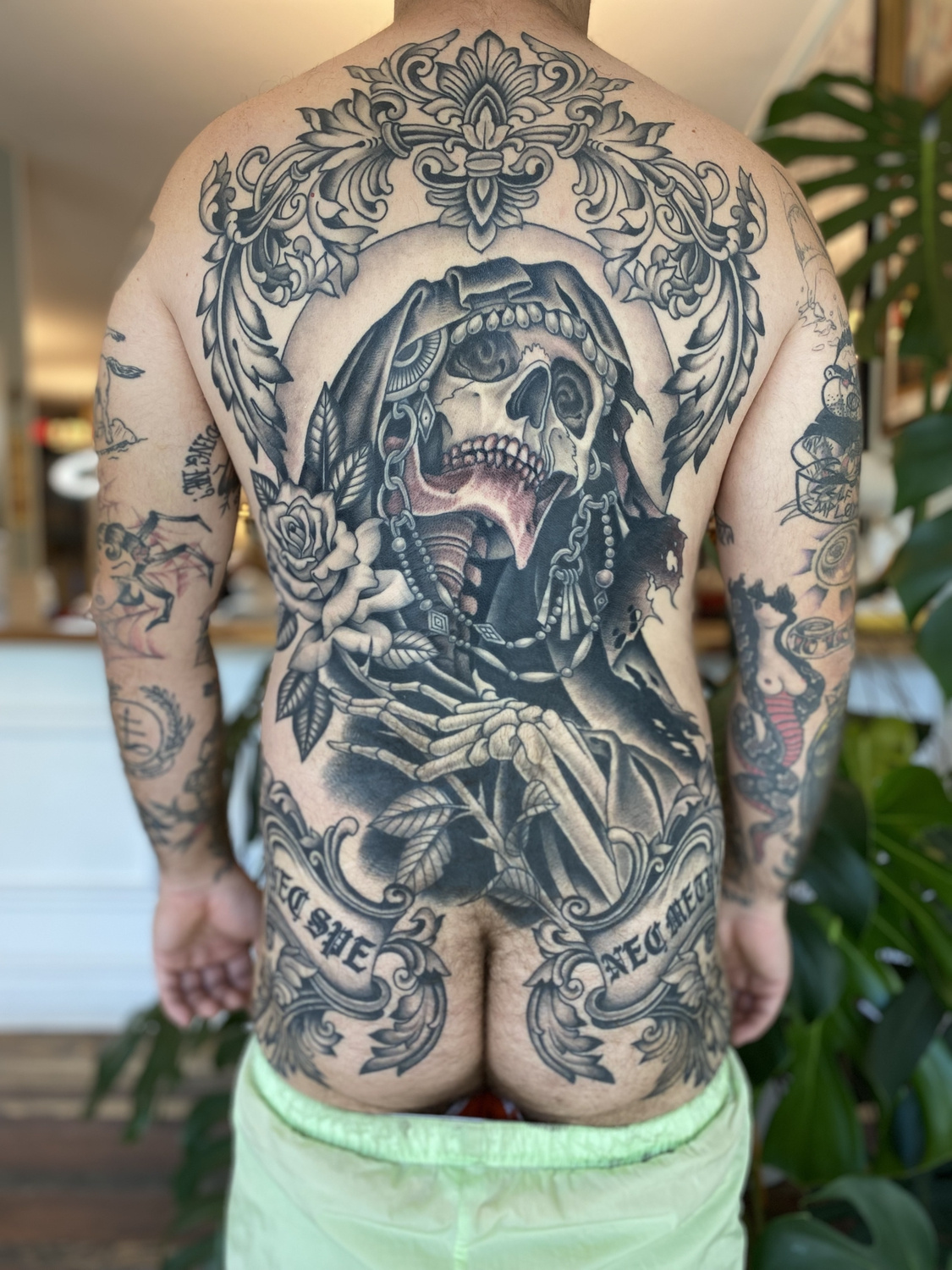
What is the most important aspect of tattooing for you?
- The constant evolution of the craft. It’s important not to be stagnant, and it’s really incredible that there is no ceiling on where you can take tattooing. Maybe there is, but I don’t see it yet. Tattooing is a ‘choose your own adventure’ world, so I can set my own path, which is definitely what I love most. It demands discipline, and it doesn’t always provide security. It’s also a career that encompasses my whole life, and it always comes first. Like a lot of us, I have attacks of imposter syndrome. You have to push through it daily and find the will to go on regardless. There are no shortcuts. I’m always trying to improve my technical abilities, which always feel less than great, but I suspect that will probably never go away.

Do you have favorite tattoos, clients, projects, or perhaps some unusual stories in your career?
- My favorite stuff to work on right now are back pieces. I think I like zoning out and just working away without talking for several hours. Got a few in the works right now, a double eagle fight, a battle royal, a ram and rooster fight, two skeletons making out, and a Dark Souls back piece. Some back pieces I’m very proud of that I finished this year are a medusa with a severed head, ‘the chariot’ tarot card, a Dune theme, the witch king of Angmar, a huge skull and snake with rats, a woman reclining on an eagle, a baphomet, and a princess slaying a dragon.

You are constantly on the move. We know that you even had a motorcycle trip across Europe. Can you tell us about it and share the most important events during this period?
- I've been exploring Europe more frequently over the last 15 years than the US. There's familiarity and friendships scattered across several countries. I've always been drawn to the old history in the towns and lands where the art and music of my childhood came from.
I wanted to do an extended stay bridging 2017-2018 and combine it with another love of mine: motorcycling. What could be more romantic? I bought a beat-up 1992 Yamaha Diversion named the 'Red Rat' for 600 Euros and started my journey in Copenhagen, where I lived with a friend. I spent the summer and fall exploring Denmark and Sweden, then down to Germany and Switzerland, where I was already getting my back piece worked on by Sabine Gaffron. I visited ancient walled cities and castles in France, then spent half of winter in Spain, mainly in Barcelona where I squatted in an empty apartment with no hot water. I visited Granada, riding through the beautiful Sierra mountain ranges, seeing the old cave systems, some of them still inhabited. I visited the famous Camino Cathedral and ate delicious tapas in Santiago de Compostela.

The other half of winter was spent in Italy. I went all the way down the east coast, making stops in Tuscany, to the south tip where my family met up with me for a little vacation and visit. I rode back up the west coast, then as spring came, I headed back through Switzerland, Germany, and over to the Netherlands and Belgium. As the year came to a close, I brought the Red Rat to London UK, where it was stored with a friend. I did the last month or two by train, meeting up with some friends whose band was on tour, and then finished back in Copenhagen. The experience was difficult, and I immediately felt in over my head when I began it, but I pushed on and lived a wild existence the whole year. I think I was proving to myself that I could do anything I set my mind to.
Some special highlights include visiting Neuschwanstein Castle in southern Germany. Not just the beauty of the castle, but also the land itself was breathtaking and blew my mind. I tattooed a group of women in a small town in France in a living room while they smoked and drank wine. I saw Sleep play in Brussels because someone on the street gave me a ticket. I had a dance party on my friend's sailboat drifting through the canals of Copenhagen. There are too many sweet moments to list.
Where do you feel most comfortable?
- For most of my career, I have worked alongside my mentor and friend Kyle Hollingdrake. I think I am most comfortable working with him. I don't think it matters where.

What about tattoo conventions? How many awards do you have? And what convention was the most significant for you?
- I have worked in quite a few conventions in many places, but the most standout recent convention has been a tiny one in Utrecht, Netherlands, called 'Pitstop.' I have tattooed in the back of The Village Music and Cafe in Utrecht several times, and the owners and staff are good friends now. This past September, following the Kaiserstadt tattoo convention in Aachen, they decided to organize their own tattoo convention in their roastery, and it was a huge success. There were only 16 tattooers, all friends of the cafe, and the intimate setting felt special. Because of the cafe being such a cultural hub in the community, the turnout was incredible. It felt like everyone stopped in. I'm certain this is the beginning of a fun tradition that I feel deeply grateful to be part of.

How do you assess your popularity? And in your opinion, how can it be measured?
- I have a great client base in many parts of the world. I do my best by them, and when they're happy, I have succeeded. I don't know how to assess popularity. I've made a lot of friends in tattooing that I will have for life. Despite the old saying 'never meet your heroes,' I've met many of mine in this industry, and most of them are actually fantastic people and are now my friends. I don't really engage with the construct of 'popularity.' It makes me think of high school, where I was definitely not popular. We're all just human beings, and hype is empty unless there's something to back it up. Mostly if you're a good person, we will probably be friends.
I have some clients who have been with me since day one, and it's wild to really comprehend. In my times of doubt, it's the proof of their ongoing loyalty and love that convinces me I can rely on my capabilities as a tattooer. That, to me, is the most satisfying and hard-won measure of success. I started tattooing just as Instagram was gaining popularity, so we kind of grew up together. It's definitely changed the tattoo world, both for the better and for the worse. I try not to let it push me around in terms of appeasing the algorithm or letting it dictate my work. I'm lucky to have lots of followers, so that's easy for me to say, but I know if Instagram disappeared tomorrow, I would be totally fine. I actually think Instagram has gotten worse over the last 5 years. There's a lot of restructuring in the way it works, and it's no longer that reliable to me. That's why I made a website last year, so there is a place where people can see my work and interact with me that is within my control and not subject to bots or algorithms.

Many successful tattoo artists strive to share their acquired experience. Tell us if you have any such activities in your life and for whom they are.
- Sometimes I feel like I just started tattooing yesterday! If you're wondering if I would ever take on an apprentice, my knee-jerk answer is no. However, an important lesson that tattooing has taught me is never to say never. I think if the timing and the person were just right, it could happen. I travel so much and am so occupied with life that it doesn't seem possible now. I've kept a low profile so far in terms of tattoo-adjacent projects until recently. I was invited by Paul Dobleman to create flash for Tattoo Dream, a store where artists can download tattoo flash as a brush set on Procreate.
I did a set of 20 wolves, all different body poses and heads. It felt good to be featured alongside the other artists whom I admire and to contribute something to the community that some will find helpful. I'd love more opportunities like this. I often think of something Thomas Hooper told me years ago, 'it's not just about what tattooing can do for you, it's also about what you can do for tattooing.' I want to contribute my drop of goodness to the ongoing history of tattooing, which we are all a part of.

What is the most important thing in your career as a tattoo artist? What goals do you set for yourself?
- I'm a harsh critic of my work and often say 'I hate everything I've done,' which of course, all artists say about themselves but is also not fair to say out loud to a client. Also, my mood toward some pieces changes constantly, so my judgment cannot be trusted. I do have moments on some projects where I feel 'I'm really on to something and it could be great!' Capturing more of that feeling is my most basic goal. I think this feeling feeds back into the work, and the client benefits too. There is so much we are not in control of, but seeking this feeling is my motivation to work hard and grow.

Share your creative plans for the near future.
- Right now, I'm working on launching some new back piece ideas that I'd love to put out there and see who's into it. Just trying to get proactive about the direction I want to go in. I have some plans for some guest spots and conventions in the US that I'm currently getting organized for. I have been setting aside more time to do oil painting; one day I'll make enough to have a real exhibition. The biggest thing I'm excited for is the Truly Yours tattoo convention put on by my friend Clemens Hahn, in Mannheim, Germany. The event is taking place on June 29-30, and I am curating an exciting group art show called 'Truth Be Told' that will be part of the convention.
So far, most of the artists that I have invited have shown interest in participating, and if it turns out as I have planned, it will be a really special art show. The convention is the first of its kind, and I am so proud to be playing this leadership role in the event. I had such a great year traveling and tattooing with friends, doing conventions, and making art. I just turned 40, and I have the feeling the best is yet to come. I am aiming high this year!



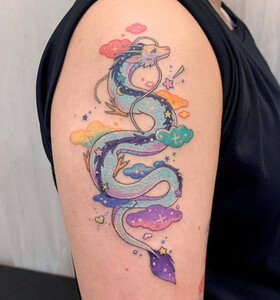

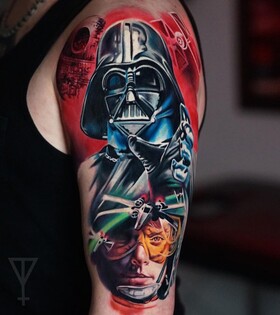
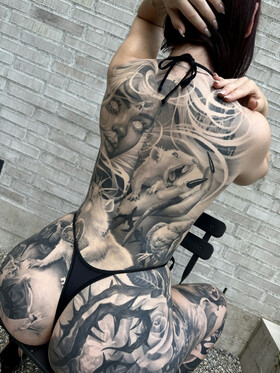
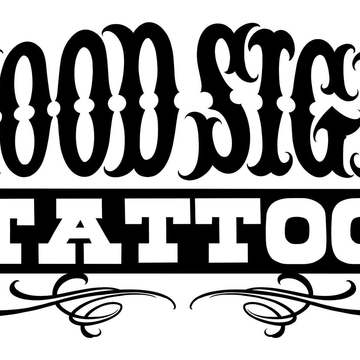
Comments (0)